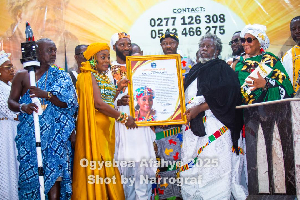The unfortunate incidence of slave trade is one which will forever be etched in the hearts and minds of Africans.
However, a significant memory of the trade are the forts and castles, built by colonial masters, which still stand erect for citizens and tourists alike to have a feel of the horrific experience.
Thousands of slaves were held in small compartments or dungeons of these fortresses, whereas the masters reserved the larger spaces for themselves and their families.
Like other African countries, government after government decided to preserve the monuments for future generation to know the ordeals their forefathers went through in the hands of Western rulers.
However, although there are quite a number of Fortes or Castles privy to Ghanaians such as the Cape Coast Castle, Elmina Castle, Ussher Forts to mention a few, there are others which may not ring a bell when mentioned.
This year, Ghana is marking the 400th anniversary of the start of the slave trade.
The remains of forts and castles where slaves were held are haunting monuments of the tribulations of captured Africans centuries ago.
Here are some Colonial Fort you probably did not know existed in Ghana:
Fort de Goede Hoop

Fort de Goede Hoop also known as Fort Good Hope in English was built on the Dutch Gold Coast and was established in 1667 near Senya Beraku.
Its purpose was to serve the gold trade with Akim, located north of Agona but the gold trade was not very prosperous. Hence slaves were sold at the fort. The initial size of the building was a small triangular fort which had become too small for the slave business.
By 1715, the Dutch decided to double it in size by breaking away the diagonal and making it square-shaped. A slave prison was made in the southwest bastion of the fort. In the second half of the 18th century, the fort was surrounded by an outer wall.
Fort de Goede Hoop was later captured and occupied by the British between 1782 and 1785, as well as by the local Akim population between 1811 and 1816.
By 1868, the fort was ceded to the United Kingdom in a large trade of forts between the Netherlands and Britain.
Fort William

Fort William was built in the nineteenth century by its then commander, Brodie Cruickshank in 1753, after the British thwarted a French attempt to establish a fort at the same place.
It was originally known as Anomabo Fort.
An interesting bit is that two forts were established earlier at the same site - one in 1640 by the Dutch, another in 1674 (Fort Charles) by the English. However, Fort Charles was abandoned in the late 17th century.
Fort William can be found in Anomabo in the Central Region.
Fort Metal Cross

Fort Metal Cross, formerly known as Fort Dixcove, is a small fort which is about 20-minute walk from Busua Beach.
Built by the English in 1691-97, possibly on the site of an earlier post, this fort has the typical history of many occupiers and abandonment. The Dutch named it Metalen Kruis in 1868 and ceded it to Britain in 1872.
This fort was extensively restored in 1954-56.
Fort Nassau

Located near Moree in the Central Region, Fort Nassau was the first fort built by the Dutch due to the unfamiliarity of the Dutch with buildings in the tropics. It was established on what became the Dutch Gold Coast and notorious for its unhealthy conditions.
The Dutch, in 1624, expanded the fort.
Fort Nassau served as the capital of the Dutch Gold Coast from its establishment until 1637, when the Dutch captured Fort Elmina from the Portuguese.
Fort Batenstein

Fort Batenstein was a fort and trading post established by the Dutch on the Gold Coast in 1656. It was situated near Butre and was ceded with the entire Dutch Gold Coast to Britain in 1872.
The Treaty of Butre was signed on 27 August 1656 between the Dutch and the Ahanta at Fort Batenstein
Fort Amsterdam

Fort Amsterdam is a fort in Kormantin in the Central region. It was built by the English between 1638 and 1645 as Fort Cormantin or Fort Courmantyne and was captured by admiral Michiel de Ruyter of the Dutch West India Company in 1665.
Fort San Sebastian

Fort San Sebastian located in Shama, is the third oldest fort in Ghana. Originally built as a Dutch lodge in 1526. It was later converted into a fort by the Portuguese in 1590.
Abandoned in 1600, the Dutch returned and restored the fort in 1638. Temporally in English hands, it was again abandoned sometime before 1870 and was ceded to Britain in 1872.
Fort Prinzenstein

Fort Prinzenstein is a fort located at Keta, which was used in the slave trade. It is the only fort at the east of Accra. Established in the early 1700s by the Dutch, Fort Prinzenstein is about 200-300 yards from the sea. It was purchased by the British in 1850 after the Danes built the present fort in 1784.
Fort Patience

Fort Patience was initially built as a stone trading lodge in 1697 at the request of the King of Acron, with whom the Dutch had a treaty. The edifice was situated between the kingdoms of Fante and Agona, with whom the British had a treaty.
By 1721 the lodge had been converted into a defensive fort, which sat on a craggy peninsula just out of the township to the south, offering a commanding view of Apam's harbour to the north, and the Gulf of Guinea coast to the south, east, and west.
Fort Patience is located in Apam in the Central Region.
Fort Orange

Fort Orange was built as a trading post on the Dutch Gold Coast in 1642, near Sekondi. The trading post was enlarged into a fort in 1690. It was joined by an English Fort in Sekondi in 1682. It was sold with the rest of the Dutch Gold Coast to the United Kingdom in 1872, and now serves as a lighthouse.
Fort San Antonio

Fort San Antonio in Axim like many forts, started as a Portuguese trading post in 1502, and changed hands many times among English, European and local powers over a long history, until its final ownership by the British was established in 1872.
This fort has the distinction of being recognized as the second fortification built in today's Ghana by the Portuguese.
Fort St. Jago/Fort Coenraadsburg or Conraadsburg

Fort Coenraadsburg or Conraadsburg also Fort São Tiago da Mina, is a fort on the Dutch Gold Coast. Within a walking distance to Elmina Castle, Fort St Jago originated as a chapel built between 1555 and 1558 by the Portuguese, which was later converted into a lodge and watch tower. From the vantage point of this nearby hill, the Dutch launched their successful land attack on Elmina Castle.
Its primary purpose was to provide military protection to the Castle and to serve as a disciplinary institution for European convicts and malcontents.
Fort Gross Frederiksburg, Princestown (1683)

The history of the Brandenburg fort, Fort Gross Fredericksburg, still reverberates in the Caribbean, via the John Canoe festivals. On Manfro Hill, in Princestown, in the Western Region of Ghana, the Brandenburg Africa Company, led by Benjamin Raule, under the patronage of the Frederick William of Brandenburg, built the luxurious Fort Gross Fredericksburg as their headquarters, between 1683 and 1684, desiring also ‘a place in the sun’ and the riches of the Gold Coast. It is the only fort in Ghana with Germanic authors.
A farmyard lookalike, the fort had 32 cannons upon completion; and only a strong defence would have been a sufficient deterrent to assaults from the Dutch and British, who resented further foreign intrusion into the area. This was especially so because as few Brandenburg ships arrived on the coast, the fort traded with merchants from all nations, becoming the hub for smugglers along the coast.
Fort Gross Friedericksburg is currently a rest house. It can accommodate ten people at a time
Sad news is that these forts, over the years, have not received the attention given the well-known ones and most of them have already disappeared from where they once stood whilst others are still rooting away
Sources:http://www.ghanamuseums.org, easytrackghana.com, wikipedia.com
General News of Friday, 18 October 2019
Source: www.ghanaweb.com
Colonial forts Ghanaians had no idea existed
Entertainment












